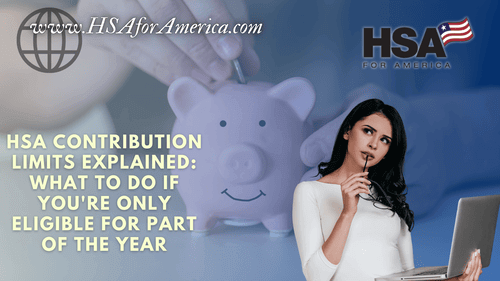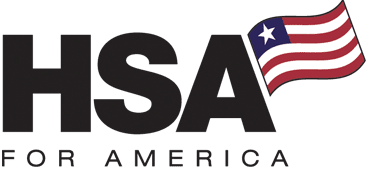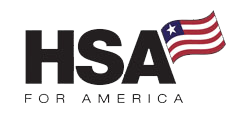Health Savings Accounts (HSAs) are a popular savings tool, but like other tax-advantaged accounts, there are HSA contribution limits set by the IRS.

They let you save pre-tax dollars for medical expenses, keep what you don’t use year after year, and even grow your account tax-free for retirement. But what happens if you only qualify for part of the year?
Here’s everything you need to know about prorating contributions and maximizing your HSA savings.
Why HSAs Are So Powerful
HSAs are paired with High Deductible Health Plans (HDHPs) and offer several advantages:
- Tax-free contributions. The money you deposit into your HSA is deducted from your taxable income.
- Tax-free growth. Interest and investment earnings grow tax-free.
- Tax-free withdrawals. As long as you use the funds for qualified medical expenses, you’ll never pay taxes on them.
Learn More: The Tax Treatment of Health Savings Accounts
Compare Pricing on the Best Insurance Plans Available
HSA Eligibility
To contribute to an HSA, you must meet these eligibility requirements:
- Be covered under an HDHP.
- Have no other disqualifying coverage (e.g., Medicare or a traditional health plan).
- Not be claimed as a dependent on someone else’s tax return.
LEARN MORE: How Much Can an HSA Save in Taxes?
HSA Contribution Limits
For 2025, the maximum allowable HSA contribution limits are:
- $4,300 for individuals.
- $8,550 for families.
- An additional $1,000 catch-up contribution if you’re 55 or older.
While both individuals and their employers can make contributions to an individual or family HSA, the total combined contribution cannot exceed these numbers. If you exceed them, you may have to pay a penalty.
Note: The more you contribute, the more you save on taxes—both in the current year and down the road when you have medical expenses that you can now pay with tax-free dollars, via your HSA.
The “Last Month Rule” for HSA Contributions
Generally, the law allows you to make a full annual contribution to your health savings account, as long as you were eligible on December 1st.
That means you can contribute the full annual limit, even if you switch to an HDHP plan in November.
But there’s a catch: You must maintain your eligibility for the rest of the following calendar year. This is called the testing period.
If you lose your eligibility during the testing period, the IRS will recapture the extra contribution, and assess taxes and penalties. This could be very expensive.
So be sure to keep your HDHP in force, or switch to a new one using a special enrollment period. That way you can maintain your eligibility all year long.
LEARN MORE: How to Switch to a Health Savings Account (HSA) Plan (And Why You Should Do It!)
What if I Don’t Qualify For The Last Month Rule?
Good news: You’re still in luck.
If you’re only eligible for part of the year, but for some reason, you weren’t eligible on December 1st, and don’t qualify for the Last Month Rule, you’ll need to prorate your contributions over the year.
So how much can you contribute to an HSA? You can easily calculate that using this simple formula.
Annual HSA (Contribution Limit ÷ 12) × Number of Eligible Months = Your Contribution Limit
For example:
- You’re an individual with HDHP coverage starting July 1.
- You’re eligible for six months (July through December).
($4,150 ÷ 12) × 6 = $2,075 contribution limit.
Alternatively, if you’re covered under a family plan, the calculation is as follows:
($8,300 ÷ 12) × 6 = $4,150 contribution limit.
Prorating ensures you stay within IRS limits and avoid penalties for over-contributing.
What If You Don’t Have an HSA or HDHP?
You can only make HSA contributions if you’re enrolled in a qualifying high deductible health plan.
If you’re not sure where to start, here’s how:
- Shop for an HDHP. Look for plans with lower premiums and higher deductibles that qualify for an HSA.
- Open an HSA. Once you have an HDHP, set up an HSA account through a bank, credit union, or specialized provider like HSA Secure.
An Affordable Alternative
Traditional health insurance products, including HDHPs, provide effective protection against unexpected catastrophic medical bills.
But they are also very expensive. Despite the so-called “Affordable” Care Act, millions of American families are still priced out of the market. Especially if they don’t receive premium tax credit subsidies under the ACA.
Fortunately, there’s an affordable non-insurance alternative that still maintains your eligibility to contribute to health savings accounts: the HSA Secure health sharing plan.
The HSA Secure plan could be a great match for you if you meet these eligibility criteria:
- You are a business owner
- You have 1099 income as an independent contractor
- You have verifiable income from self-employment
Health sharing works best if you’re in good health with no major pre-existing conditions.
What is Health Sharing?
Health sharing plans like HSA Secure are not insurance products.
Instead, these plans feature a non-insurance, community-based approach. With health sharing, where like-minded, health-conscious members contribute money each month. These funds go to help cover the medical expenses of their fellow members.
They provide a lot of protection against high and even catastrophic medical costs – and they are available at around half the cost of full-fledged, unsubsidized traditional health insurance premiums.
Health sharing works best for those who don’t get a subsidy under the Affordable Care Act, and who don’t have major pre-existing conditions. That’s because health sharing plans impose a waiting period before they will share costs related to preexisting conditions.
Why HSA Secure?
There are many health sharing plans that provide a similar cost advantage compared to traditional health insurance.
But HSA Secure is the only major health sharing plan designed to preserve your eligibility for HSA contributions.
HSA Secure has two components:
First, it’s a powerful health sharing plan that can handle even catastrophic medical costs. Second, it includes a built-in Minimum Essential Coverage (MEC) plan for preventive care. This component handles the ten essential health benefits required for HDHPs under the Affordable Care Act, including preventive care benefits.
Because of the MEC component, HSA Secure qualifies members to make HSA contributions.
TAKE OUR QUIZ! Health Sharing or Traditional Insurance: Which Health Plan Is Best For Me?
Compare Pricing on the Best HealthShare Plans Available
HSA Contribution Limits Summed Up
Health Savings Accounts (HSAs) are a smart way to save.
The more you contribute to your HSA and use it for medical expenses, the more you can reduce your tax burden. Even if you qualify for only part of the year, prorating your contributions ensures you maximize your savings while staying within IRS guidelines.
If you’re not yet taking advantage of an HSA or an HDHP, now is the ideal time to get started. For expert guidance and help finding the best plan, contact us.
Let one of our Personal Benefits Managers help you gain more control over your healthcare and your taxes! Consultations are free, and there’s never any obligation.
For Further Reading:



